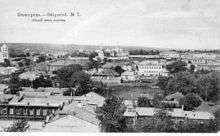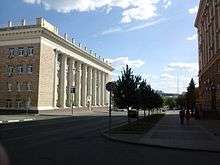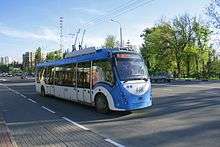Belgorod
Belgorod (Russian: Белгород, IPA: [ˈbʲeɫɡərət]) is a city and the administrative center of Belgorod Oblast, Russia, located on the Seversky Donets River 40 kilometers (25 mi) north of the border with Ukraine. Population: 356,402 (2010 Census);[7] 337,030 (2002 Census);[13] 300,408 (1989 Census).[14]
Belgorod Белгород | |
|---|---|
City[1] | |
 View of the central part of the city | |
 Flag  Coat of arms | |
| Anthem: none[2] | |
Location of Belgorod 
| |
 Belgorod Location of Belgorod  Belgorod Belgorod (Belgorod Oblast) | |
| Coordinates: 50°36′N 36°36′E | |
| Country | Russia |
| Federal subject | Belgorod Oblast[1] |
| Founded | 1596[3] |
| Government | |
| • Body | Council of Deputies[4] |
| • Mayor[5] | Yuri Galdun[6] |
| Elevation | 130 m (430 ft) |
| Population | |
| • Total | 356,402 |
| • Estimate (January 2015)[8] | 384,425 |
| • Rank | 49th in 2010 |
| • Subordinated to | city of oblast significance of Belgorod[1] |
| • Capital of | Belgorod Oblast[1], city of oblast significance of Belgorod[1] |
| • Urban okrug | Belgorod Urban Okrug[9] |
| • Capital of | Belgorod Urban Okrug[9] |
| Postal code(s)[10] | 308000–308002, 308004–308007, 308009–308020, 308023–308027, 308029, 308031–308034, 308036, 308099, 308700, 308880, 308890, 308899, 308940, 308960, 308961, 308967, 308971–308974, 308991–308994 |
| Dialing code(s) | +7 472[11] |
| City Day | 5 August[12] |
| Website | www |
History
The name Belgorod (Белгород) in Russian literally means "White city", compounding the sememes "белый" (bely, "white, light") and "город" (gorod, "town, city"). The city thus acquired its name because the region was rich in limestone.[15] Etymologically, the name corresponds to other Slavic city-names of identical meaning: Belgrade, Belogradchik, Białogard, Biograd, Bilhorod, and Bilhorod-Dnistrovskyi.
Records first mention the settlement in 1237, when the Mongol-led army of Batu Khan ravaged it. It is unclear whether this Belgorod stood on the same site as the current city. In 1596 Tsar Feodor Ioannovich of Russia ordered its re-establishment as one of numerous forts set up to defend Muscovy's Southern borders from the Crimean Tatars.[3] In the 17th century Belgorod suffered repeatedly from Tatar incursions, against which Russia built (from 1633 to 1740) an earthen wall, with twelve forts, extending upwards of 200 miles (320 kilometres) from the Vorskla in the west to the Don in the east, and called the Belgorod line. In 1666 the Moscow Patriarchate established an archiepiscopal see in the town.[16]

After the Russian border moved south following successful wars against the Polish–Lithuanian Commonwealth in the second half of the 17th century, the fortress fell into disrepair; the town became part of the Kursk Governorate.
Tsar Peter the Great visited Belgorod on the eve of the Battle of Poltava (1709). A dragoon regiment had its base in the town until 1917.
Ioasaph of Belgorod, an 18th-century bishop of Belgorod and Oboyanska, became widely venerated as a miracle worker and was glorified as a saint of the Russian Orthodox Church in 1911.
20th century

Soviet power was established in the city on 26 October (November 8), 1917. On 10 April 1918, troops of the Imperial German Army occupied Belgorod. After the conclusion of the Brest-Litovsk peace treaty of 9 February 1918 the demarcation line passed to the north of the city. Belgorod became part of the newly proclaimed Ukrainian People's Republic (February to May 1918) and Ukrainian State headed by Hetman Pavlo Skoropadskyi.
On 20 December 1918, after the overthrow of German-backed Skoropadskyi, the Soviet Red Army regained control over the city, which became part of the RSFSR. From 24 December 1918 to 7 January 1919, the Provisional Workers' and Peasants' Government of Ukraine, then led by General Georgy Pyatakov, was based in Belgorod. The city served as the temporary capital of the Ukrainian People's Republic. From 23 June to 7 December 1919 the Volunteer Army occupied the town as part of White-controlled South Russia.
From September 1925 the territorial 163rd Infantry Regiment of the 55th Infantry Division of Kursk was stationed in Belgorod. In September 1939 it was deployed to the 185th Infantry Division.
On 2 March 1935, the Presidium of the Central Executive Committee of the Soviet Union decided to allocate the city of Belgorod, Kursk region, into an independent administrative unit directly subordinate to the Kursk Regional Executive Committee.
The German Wehrmacht occupied Belgorod from 25 October 1941 to 9 February 1943. The Germans re-captured it on 18 March 1943 in the final move of the Third Battle of Kharkov. On 12 July 1943, during the Battle of Kursk, the largest tank battle in world history took place near Prokhorovka, and Red Army definitively retook the city on 5/6 August 1943. The Belgorod Diorama is one of the World War II monuments commemorating the event.
In 1954 the city became the administrative center of Belgorod Oblast. From this time the rapid development of the city as a regional center began.[17]
Belgorod is an administrative, industrial and cultural center of Belgorod Oblast, established in 1954. The major educational centers of the city are Belgorod State University, the Belgorod Technological University, the Belgorod Agrarian University, and the Financial Academy.
Belgorod Drama Theater is named after the famous 19th-century actor, Mikhail Shchepkin, who was born in this region.
On 22 April 2013, a mass shooting occurred at approximately 2:20 PM Moscow time on a street in Belgorod. The shooter, identified as 31-year-old Sergey (Sergei) Pomazun (Russian: Сергей Помазун), opened fire with a semi-automatic rifle on several people at a gun store and on a sidewalk, killing all six people whom he hit: three people at the store and three passers-by, including two teenage girls. Pomazun was later apprehended after an extensive day-long manhunt; during his arrest, he wounded a policeman with a knife. He was sentenced to life in prison on 23 August 2013.
Administrative and municipal status

Belgorod is the administrative center of the oblast.[1] Within the framework of administrative divisions, it is incorporated as the city of oblast significance of Belgorod—an administrative unit with status equal to that of the districts.[1] As a municipal division, the city of oblast significance of Belgorod is incorporated as Belgorod Urban Okrug.[9]
Climate
Belgorod's climate is humid continental (Köppen climate classification Dfb slightly cooler than Dfa) featuring moderate precipitation. Winters are rather cold and changeable with frequent warmings followed by rains. Temperatures may occasionally fall below −15 °C (5 °F) for about one week or more. Summer is warm and either humid and rainy or hot and droughty. Autumn is mild and rainy. The Belgorod reservoirs get covered with ice by the end of November or the beginning of December, and the ice layer typically lasts until March or April.
- average year temperature: + 7.7 °C
- average humidity: 76%
- average wind speed: 5–7 m/s
- average precipitation 380–620 mm (14.96–24.41 in), mostly in summer.
| Climate data for Belgorod | |||||||||||||
|---|---|---|---|---|---|---|---|---|---|---|---|---|---|
| Month | Jan | Feb | Mar | Apr | May | Jun | Jul | Aug | Sep | Oct | Nov | Dec | Year |
| Record high °C (°F) | 6.6 (43.9) |
12.3 (54.1) |
19.4 (66.9) |
25.6 (78.1) |
34.4 (93.9) |
35.7 (96.3) |
38.9 (102.0) |
36.3 (97.3) |
33.5 (92.3) |
27.6 (81.7) |
17.4 (63.3) |
8.9 (48.0) |
38.9 (102.0) |
| Average high °C (°F) | −3.0 (26.6) |
−2.9 (26.8) |
2.8 (37.0) |
13.2 (55.8) |
20.5 (68.9) |
23.9 (75.0) |
26.0 (78.8) |
25.2 (77.4) |
18.6 (65.5) |
11.1 (52.0) |
1.9 (35.4) |
−2.6 (27.3) |
11.3 (52.3) |
| Daily mean °C (°F) | −6.1 (21.0) |
−6.1 (21.0) |
−0.4 (31.3) |
8.9 (48.0) |
15.5 (59.9) |
19.4 (66.9) |
21.8 (71.2) |
21.2 (70.2) |
15.1 (59.2) |
8.0 (46.4) |
−0.4 (31.3) |
−5.6 (21.9) |
7.7 (45.9) |
| Average low °C (°F) | −10.0 (14.0) |
−9.9 (14.2) |
−4.0 (24.8) |
−0.4 (31.3) |
9.7 (49.5) |
14.1 (57.4) |
16.8 (62.2) |
16.3 (61.3) |
10.9 (51.6) |
4.7 (40.5) |
−2.8 (27.0) |
−9 (16) |
3.5 (38.3) |
| Record low °C (°F) | −34.5 (−30.1) |
−29.7 (−21.5) |
−31.1 (−24.0) |
−9.7 (14.5) |
−3.1 (26.4) |
2.9 (37.2) |
8.7 (47.7) |
7.1 (44.8) |
−2.5 (27.5) |
−6.2 (20.8) |
−21 (−6) |
−32.1 (−25.8) |
−34.5 (−30.1) |
| Average precipitation mm (inches) | 52 (2.0) |
40 (1.6) |
36 (1.4) |
46 (1.8) |
48 (1.9) |
67 (2.6) |
72 (2.8) |
53 (2.1) |
49 (1.9) |
40 (1.6) |
52 (2.0) |
50 (2.0) |
605 (23.8) |
| Average precipitation days | 10 | 9 | 8 | 7 | 7 | 8 | 9 | 7 | 7 | 7 | 10 | 11 | 100 |
| Source 1: belgorod-meteo.ru [18] | |||||||||||||
| Source 2: world-climates.com [19] | |||||||||||||
Transportation


Since 1869, there has been a railway connection between Belgorod and Moscow.[20] Belgorod is served by the Belgorod International Airport (EGO).
Trolleybus
Length of trolley lines is over 120 km (75 mi). Trolleybus city park consists of 150 pieces of equipment, mainly Russian-made trolley ZiU-682V, 2 units ZiU-683, operated since 1990, and 3 units ZiU-6205, 30 units "Optima", and also has one trolley Skoda-VSW -14Tr, which started operation in 1996. In 2002, the city administration purchased 15 new trolleybuses ZiU-682G, and in 2005 bought another 20 new trolleybuses ZiU-682G, and in 2011 - 30 trolleybuses Trolza-5275.05 "Optima", and in 2013 - 20 new trolleybuses ACSM-420.
Bus
The city has two bus stations: Bus Belgorod, Belgorod- 2 Bus Terminal (located on the forecourt ), as well as bus stop complex Energomash. The Energomash bus station is mainly for commuting buses. From the bus station Belgorod-2 buses go mainly to nearby regional centers, and departure of buses in accordance with the arrival of trains. In 2019 Belgorod bought 20 new buses named Liaz.
Culture and art
Theaters
- Belgorod Drama Theater
- Belgorod Puppet Theater
- Two monkeys, Belgorod clowning theater
Museums
- Belgorod historical museum
- Belgorod Art Museum
- Belgorod Museum of Folk Culture
- The Belgorod Diorama Of The Tank Battle of 1943
Festivals
- White mask, a festival of street arts
Notable people
- Joasaph of Belgorod, 18th century bishop
- Svetlana Khorkina, Olympic gymnast
- Natalia Zuyeva, Olympic rhythmic gymnast
- Alexey Shved, basketball player
- Vadim Moshkovich, Federation Council member
- Timur Khaliullin, Organist
Twin towns – sister cities
Belgorod is twinned with:[21]









References
Notes
- Law #248
- According to Article 5 of the Charter of Belgorod, the symbols of Belgorod include a flag and a coat of arms but not an anthem.
- Энциклопедия Города России. Moscow: Большая Российская Энциклопедия. 2003. p. 39. ISBN 5-7107-7399-9.
- Charter of Belgorod, Article 26
- Charter of Belgorod, Article 35
- Official website of Belgorod. Konstantin Alexeyevich Polezhayev Archived 23 September 2016 at the Wayback Machine, Head of the City Administration (in Russian)
- Russian Federal State Statistics Service (2011). "Всероссийская перепись населения 2010 года. Том 1" [2010 All-Russian Population Census, vol. 1]. Всероссийская перепись населения 2010 года [2010 All-Russia Population Census] (in Russian). Federal State Statistics Service.
- Belgorod Oblast Territorial Branch of the Federal State Statistics Service. Численность населения Белгородской области по муниципальным образованиям на 1 января 2015 года (in Russian)
- Law #159
- Почта России. Информационно-вычислительный центр ОАСУ РПО. (Russian Post). Поиск объектов почтовой связи (Postal Objects Search) (in Russian)
- http://www.dialingcode.com/country/russia-belgorod
- Charter of Belgorod Oblast, Article 6
- Russian Federal State Statistics Service (21 May 2004). "Численность населения России, субъектов Российской Федерации в составе федеральных округов, районов, городских поселений, сельских населённых пунктов – районных центров и сельских населённых пунктов с населением 3 тысячи и более человек" [Population of Russia, Its Federal Districts, Federal Subjects, Districts, Urban Localities, Rural Localities—Administrative Centers, and Rural Localities with Population of Over 3,000] (XLS). Всероссийская перепись населения 2002 года [All-Russia Population Census of 2002] (in Russian).
- "Всесоюзная перепись населения 1989 г. Численность наличного населения союзных и автономных республик, автономных областей и округов, краёв, областей, районов, городских поселений и сёл-райцентров" [All Union Population Census of 1989: Present Population of Union and Autonomous Republics, Autonomous Oblasts and Okrugs, Krais, Oblasts, Districts, Urban Settlements, and Villages Serving as District Administrative Centers]. Всесоюзная перепись населения 1989 года [All-Union Population Census of 1989] (in Russian). Институт демографии Национального исследовательского университета: Высшая школа экономики [Institute of Demography at the National Research University: Higher School of Economics]. 1989 – via Demoscope Weekly.
- "History of Belgorod | Rusmania". rusmania.com. Retrieved 5 July 2018.
-

- "Belgorod :: Regions & Cities :: Russia-InfoCentre". russia-ic.com. Retrieved 20 July 2018.
- "Belgorod oblast meteodata". Archived from the original on 3 February 2012.
- "Belgorod Climate". Archived from the original on 22 January 2016. Retrieved 15 February 2016.
- Train Station in Belgorod (in Russian) Archived 29 September 2013 at the Wayback Machine
- "Внешние связи". beladm.ru (in Russian). Belgorod. Retrieved 3 February 2020.
Sources
- Белгородский городской Совет депутатов. Решение №197 от 29 ноября 2005 г. «О принятии Устава городского округа "Город Белгород"», в ред. Решения №262 от 22 июля 2015 г. «О внесении изменений в Устав городского округа "Город Белгород"». Вступил в силу 1 января 2006 г. (за исключением отдельных положений). Опубликован: "Наш Белгород", №50, 16 декабря 2005 г. (Belgorod City Council of Deputies. Decision #197 of November 29, 2005 On the Adoption of the Charter of the Urban Okrug of the "City of Belgorod", as amended by the Decision #262 of July 22, 2015 On Amending the Charter of the Urban Okrug of the "City of Belgorod". Effective as of January 1, 2006 (with the exception of certain clauses).).
- Белгородская областная Дума. Закон №248 от 15 декабря 2008 г. «Об административно-территориальном устройстве Белгородской области», в ред. Закона №213 от 4 июля 2013 г. «О внесении изменения в Закон Белгородской области "Об административно-территориальном устройстве Белгородской области"». Вступил в силу по истечении 10 дней со дня официального опубликования за исключением положений, для которых предусмотрены иные сроки вступления в силу. Опубликован: "Белгородские известия", №219-220, 19 декабря 2008 г. (Belgorod Oblast Duma. Law #248 of December 15, 2008 On the Administrative-Territorial Structure of Belgorod Oblast, as amended by the Law #213 of July 4, 2013 On Amending the Law of Belgorod Oblast "On the Administrative-Territorial Structure of Belgorod Oblast". Effective as of 10 days after the day of the official publication; except for the portions for which other effective dates are specified.).
- Белгородская областная Дума. Закон №159 от 20 декабря 2004 г. «Об установлении границ муниципальных образований и наделении их статусом городского, сельского поселения, городского округа, муниципального района», в ред. Закона №244 от 4 декабря 2013 г. «О внесении изменения в статью 12 Закона Белгородской области "Об установлении границ муниципальных образований и наделении их статусом городского, сельского поселения, городского округа, муниципального района"». Вступил в силу по истечении 10 дней со дня официального опубликования. Опубликован: "Белгородские известия", №218–220, 24 декабря 2004 г. (Belgorod Oblast Duma. Law #159 of December 20, 2004 On Establishing the Borders of the Municipal Formations and on Granting Them a Status of Urban, Rural Settlement, Urban Okrug, Municipal District, as amended by the Law #244 of December 4, 2013 On Amending Article 12 of the Law of Belgorod Oblast "On Establishing the Borders of the Municipal Formations and on Granting Them a Status of Urban, Rural Settlement, Urban Okrug, Municipal District". Effective as of the day which is 10 days after the official publication.).
External links
- Belgorod at the Encyclopedia of Ukraine